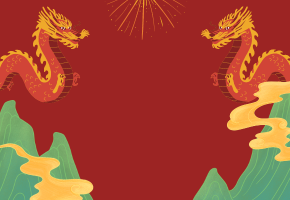Rooted in lunisolar calendars across East and Central Asia–most often the Chinese Lunar calendar and its variants–Lunar New Year starts with the second new moon after the winter solstice. In 2024, the Lunar New Year starts on Saturday, February 10, and ends on Saturday, February 24. This international holiday is observed by around 2 billion people across the globe. In China, the celebration is called chūnjié, or “Spring Festival”. In Korean, the celebration is called Seollal, while in Vietnamese it is Tết, or Tết Nguyên Đán. In the United States, Lunar New Year celebrations are a vital part of Chinese American and other Asian American communities.
The Year of the Dragon
In 2024, we will enter the Year of the Dragon in the Chinese zodiac. The Dragon customarily is highly regarded, and symbolizes many positive attributes such as bravery, success, and luck.
There are lots of ways to celebrate and learn more about Lunar New Year traditions around CSUN and in the Library.
If you’re curious to learn about Lunar New Year, you might try using it as a key phrase or searching related terms in OneSearch. There are many aspects to explore — from the economic impacts of celebrations, to environmental studies on the use of fireworks in festivals, to lesson plan development and art projects for children, to the impact of the year’s zodiac on birthing rates! Here’s a sample of interesting catalog records related to Lunar New Year and the Dragon zodiac sign from our collection:
- Deal, L., & Leubsdorf, B. (2022). Lunar New Year : fact sheet ([Library of Congress public edition].). Congressional Research Service.
- Huang, C., Zhang, S., Zhao, Q., & Lin, Y. (2021). Dragon year superstition, birth timing, and neonatal health outcomes. China Economic Review, 66, 101594-. https://doi.org/10.1016/j.chieco.2021.101594
- Zhang, X., Shen, H., Li, T., & Zhang, L. (2020). The Effects of Fireworks Discharge on Atmospheric PM 2.5 Concentration in the Chinese Lunar New Year. International Journal of Environmental Research and Public Health, 17(24).
- WONG, K.-F., & YUNG, L. (2005). DO DRAGONS HAVE BETTER FATE? Economic Inquiry, 43(3), 689–697. https://doi.org/10.1093/ei/cbi048
- Delgado, M. (2018). Case Example of a Festival: San Francisco Chinatown’s Lunar New Year Festival. In Celebrating Urban Community Life (pp. 154–163). University of Toronto Press. https://doi.org/10.3138/9781442621855-011
- Chang, M.-Y. (2010). Lunar New Year in Taiwan. International Journal of Education through Art, 6(1), 41–57. https://doi.org/10.1386/eta.6.1.41_1
- Mishra, P. (2016). Lunar New Year. In Asian American Culture : From Anime to Tiger Moms: J-Z (pp. 517–522).
- Teng, C.-C., & Yang, J. J. (2018). Chinese Lunar New Year effect, investor sentiment, and market deregulation. Finance Research Letters, 27, 175–184. https://doi.org/10.1016/j.frl.2018.03.003
If you’d like to find stories about Lunar New Year for children, be sure to browse the book display in the Teacher Curriculum Center! (2nd floor of the Library, East wing)

Other Campus and local resources
- Find a celebration or activity at your local Los Angeles Public Library branch.
- Check out this information from CSUN Today or these self-care resources from the Eisner School of Education.
The Library wishes everyone a healthy and auspicious New Year!



